How to Convert Freemium Users Using In-app Methods
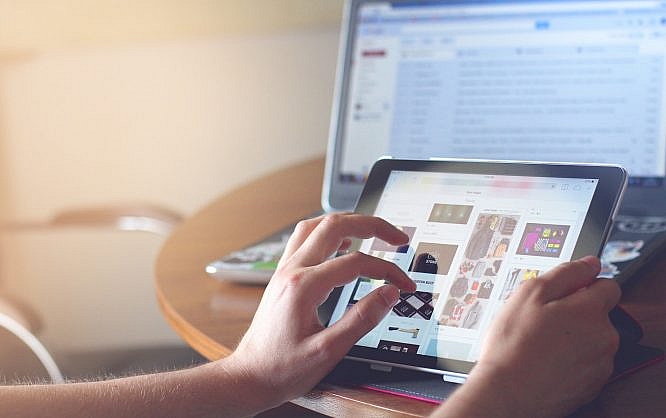
Dropbox offers cloud storage. Slack offers an online collaboration space. Candy Crush is a gaming app. All these apps have different services to offer but there is one thing common in all of them - they all follow the Freemium Model of subscription.
Freemium, which is an amalgamation of Free + Premium is one of the most widely used subscription models by websites and apps across all genres. This model has its roots in the most common psychology of users - try and then buy. Users expect to try products before they add their payment details. This is exactly why designing a freemium model can be overwhelming at some point because you need to understand what will trigger your users to make the jump from free trial to premium.
Your freemium model can be about offering an exclusive feature or prompting upgrades at regular intervals. The key to doing a freemium model right is knowing the USP of your product and thereby designing your model. Here we will look at 7 in-app methods that can help you convert your free users into loyal paying customers. Let's get started.
7 In-App Methods To Convert Freemium Users Using In-App Methods
Note: These methods are also applicable to brands that do not have a mobile app.
Freemium models are of 6 types:
- Forever Free plan + premium features
- Trial period for all premium features
- Limited use of features
- Upgrade to remove ads
- Referral-based upgrades
- In-app purchases
Now, let's look at how these models can help in converting users into paying customers.
1. Offering a forever free plan with all basic features
Many SaaS brands use this model to onboard new users. Users get access to all the basic features in the forever free plan. However, should they wish to do more advanced stuff, they will need to upgrade.
2. Tempting users with complete access to premium features for a limited time
Creating a time limit helps in creating a sense of urgency. Many products offer free trials of their paid plans ranging at:
- 7 days
- 14 days
- 30 days
The "your trial period is ending" kind of phrase helps brands create an urgency, motivating users to convert into paying customers. The idea of offering all premium features for free for a set number of days allows the users to understand the usability and benefit of your app. This makes it easier to convince free users to upgrade because they already know what they will get if they move to a paid plan.
One such app is Pipedrive. When you sign up on Pipedrive, you get to try the app for 14 days. During your trial period, you will see a subtle reminder that you are on a free trial.
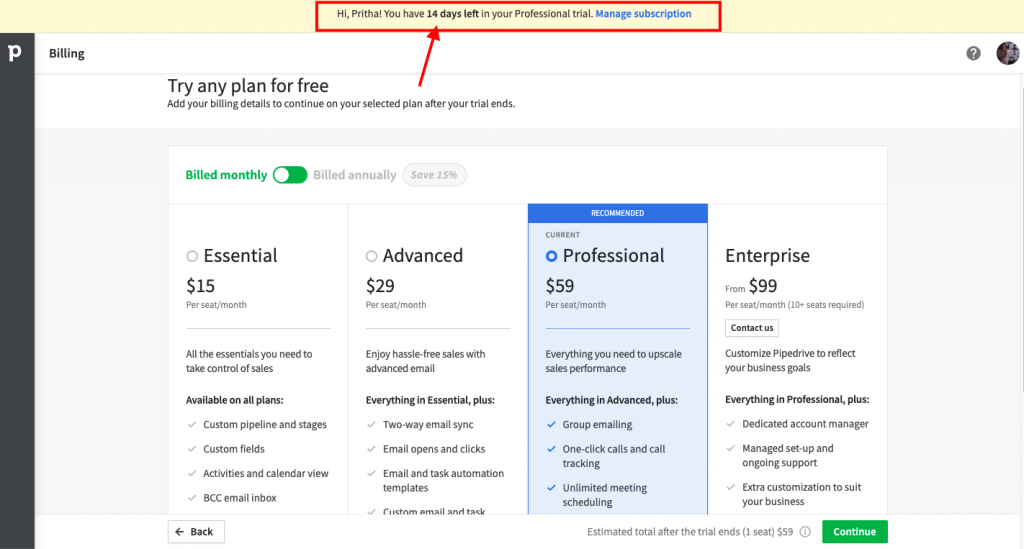
Similarly, Litmus offers a 7-day trial period with a tempting offer to upgrade while Zendesk offers a full month of a free trial.
This method is also effective in user retention. During the free trial period, users tend to use your app more frequently to leverage all premium features. Similarly, premium users will return to your app because they'd like to take full advantage of the money they are investing.
3. Add subtle reminders to upgrade on your app
Many products take the subtle approach to remind users to upgrade rather than restricting actions after a certain time. The reminders are placed organically throughout the app experience in a way that does not disrupt user interaction on the app. Each time a user completes an action in the free version, they are nudged about some added benefits that they can access if they go premium. This nudging is not forced but is extremely effective.
This is a great strategy to reduce user friction when trying to convert your free users into premium subscribers. Using phrases like "Hey! Did you know you can do this" without restricting the current user experience makes the message clear to the user but also gives users the option to choose to ignore at that moment.
The secret code here is - even if your users ignored your subtle reminder today, they will click it tomorrow or when they are ready to upgrade. This method just imbibes the message in the users' minds that upgrading will give them added benefits.
Dropbox is one brand that does this best. This cloud-storage app has a persistent but non-intrusive style of reminding users to upgrade to the premium version. However, this does not interrupt the user experience across the app for a free user. A free user continues to save files and folders and share them with their peers seamlessly.
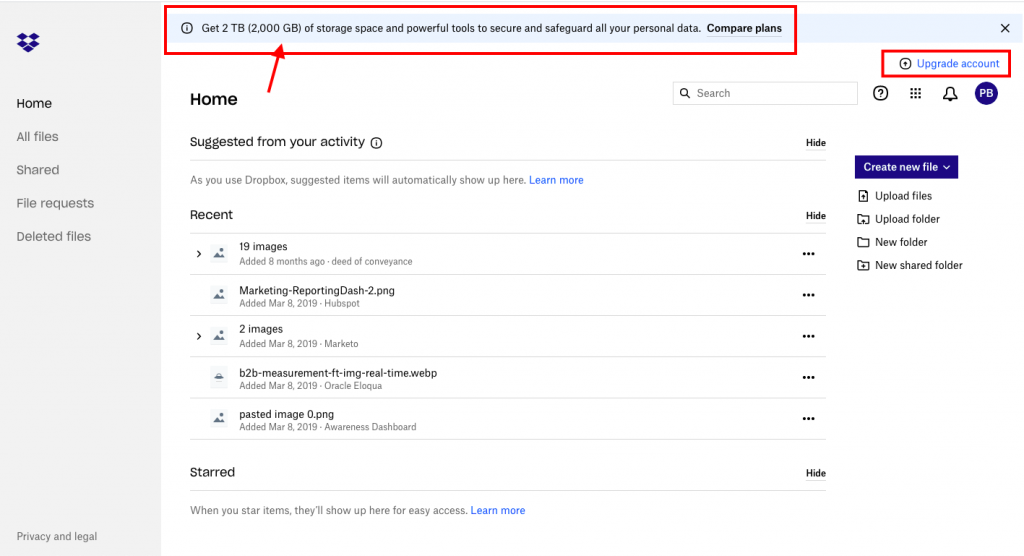
Instead of hitting an upgrade message when a user touches the free storage limitation, Dropbox goes on to persistently use prompters to remind users about the limitations in the free plan. However, these prompters are easy to dismiss.
Add to this, Dropbox often resorts to different visuals to say the same message. It calls for users' attention when a different visual shows up instead of showing the same repetitive banner.

4. Offering upgrade options to remove ads
No one likes ads that interrupt the usage of an app. Whether you are listening to music or playing a game or uploading your files, when you constantly see ads blocking your way, you don't appreciate it.
Ads are intrusive but an effective way to convert your free users to premium plans. Recently, YouTube, one of the largest video streaming platforms, started offering premium plans to see videos without ads. While the ads are only for a few seconds and YouTube mostly gives the option to 'skip ads' after 5 seconds - still having an ad-free experience whenever you want to watch a video is a tempting offer.

Plus, when the premium plans are at an affordable rate, it is easier to onboard free users as paying customers. Like majority apps, YouTube also offers a free trial of the ad-free video streaming experience before you actually start paying.
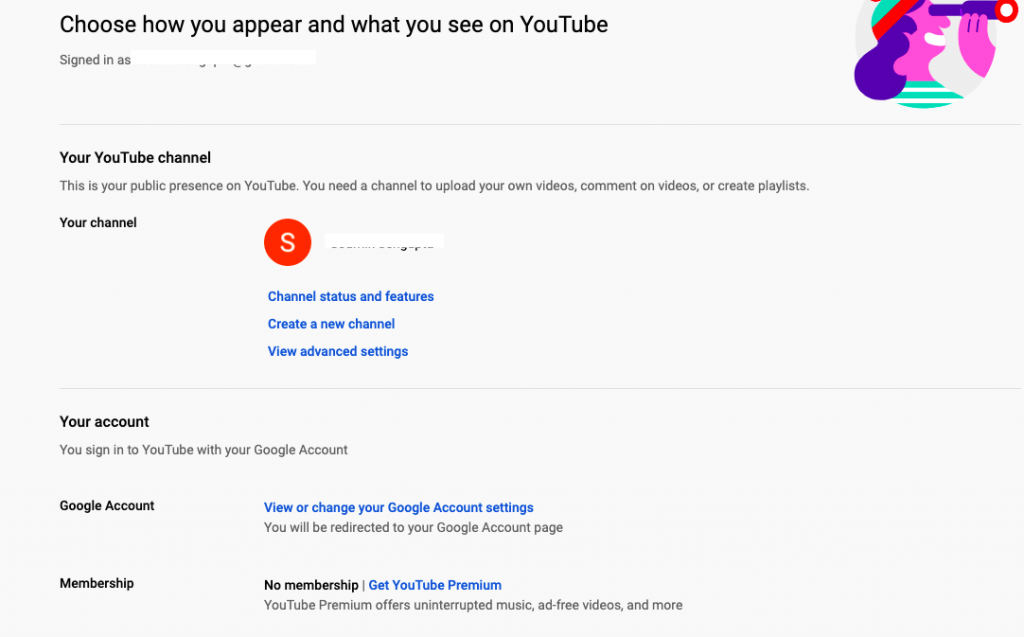
Similarly, if you have used Spotify to listen to music, you already know about the ads after every few songs. This app has a 27% conversion rate from free to premium users, indicating that using ads that are visually engaging can have a positive impact on an app.
Note: Whether it is ads on YouTube or Spotify, you will not cringe while looking at the ads. Having ads is one part of the story; having ads that won't drive your free users away is what you must take care of.
5. Using referrals to drive upgrades
This is a tricky method but really pays if done properly. Offering your users a chance to go premium when one of their referrals subscribes to your app is not just a great way to retain your existing user but also pull in new users. Trello does this wonderfully wherein if you refer someone and that person joins Trello following your referring link, you get upgraded to Trello Gold for a whole month.

This method pulls in new app users as well as shows existing users how premium features work. It is more of a mix of the free trial method and referring method.
The reason this model can be a great mode to convert free users into paying customers is - your free users don't have to do much. Just spread the word about your app and get new users onboard. In return, they get to enjoy premium benefits for 30-days. They can continue this chain or choose to upgrade by taking a premium plan.
It is worth noting that this method does not cause any friction to your free users. If you are a Trello user, you will know that even if you are not on Trello Gold, you have a smooth user experience across the app.
6. Include in-app purchases
Another way to monetize your app is to include small in-app purchases. It can be a certain feature or some credits that are valid for a certain time period. This method is most common in gaming apps. If you have played games like Candy Crush, you will know about small incentives like getting powers-up bundles at a price to cross a particular level especially when you fail to pass a level.
These apps are otherwise completely free to use. The in-app purchases are designed in such a way that you are tempted to make the purchase because you don’t want to wait until you naturally win some credits. That is why they mostly have the ‘shop’ tab in the game.
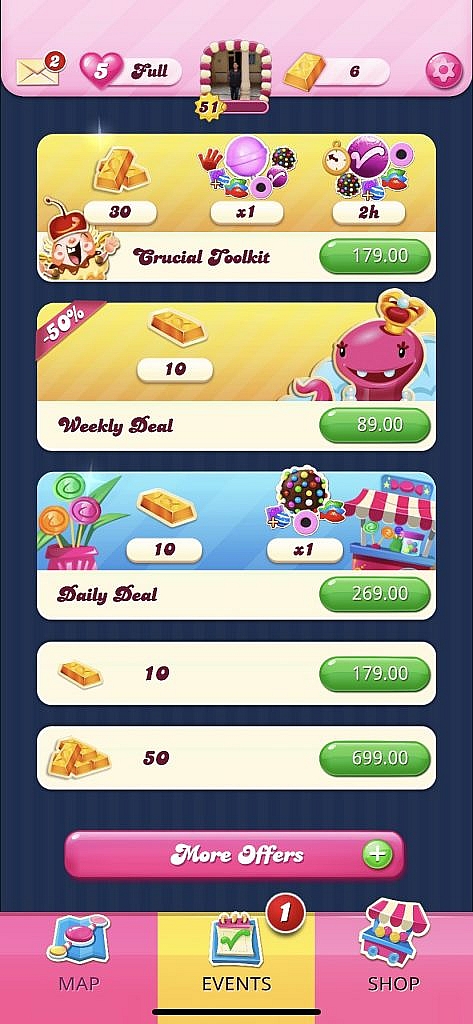
In-app purchases can be of two types -
- For consumable goods
- For non-consumable goods
Consumable goods include digital goods that users can repurchase multiple times once exhausted. For example, store credits or gaming credits, or tokens. Both iOS and Android have elaborate documentation on in-app purchases and what categories they support.
Non-consumable goods are those purchases that once purchased will remain with the user for the lifetime. For instance, in games, if you purchase a particular theme, it is non-consumable good because it has no expiry and you access it throughout the time you are using the app.
Note: When using this subscription model for your app, it is important to elaborately know what will be consumable and what not.
7. Using email drip campaigns to convert freemium users
Lastly, we have email campaigns. Email is one of the most reliable methods - whether it is to onboard new users or nurtures them and convert them into paying users. Almost all companies resort to email drip series to nurture free users and continuously showcase the benefits they will get once they go premium.
In this, how you design your message is very important. You don’t want to sound persistent and desperate. The motto is to show the benefits in the most convincing way.
(i) Offering a promo to upgrade
Offering limited and exclusive discounts via email is a great way to convert your free users. Elementor does this beautifully by offering a 25% discount on all pro plans during Black Friday.
Now, getting a 25% discount is quite a tempting offer, especially if you are frequently using the app’s free version. A worthy attempt to convert free users!

(ii) Sending reminder emails to upgrade before free trial ends
Running an email series throughout the users’ trial period keeps the user informed that their trial period will soon end. This series should not only be about “your trial is ending, upgrade”. That’s not a healthy way to convince your free users. Instead, using emails to tell why your users should consider upgrading to a premium plan soon can be of help. Educate your users at the best of your ability and show them real-time what they might be missing if they don’t upgrade. Here’s how Pipedrive does it:

The empathy with which the person reaches out to you will make you rethink your choice and in case you do have a question, you can quickly connect with him and get it resolved. This is probably the most effective way to make sure that your users feel special and they actually want to be paying customers.
For me, the star of this email is the last line. Francisca from Pipedrive is not just mindful of what you require but is also ready to encompass the fact that Pipedrive may not be ideal for you. A message like this helps products understand why a user did not want to upgrade or continue with you [making way for improved user experience in future].
Sometimes, words can have all the power in an email!
Conclusion
These are some of the effective ways to convert your free app users into paying customers. The freemium model has been around for quite some time now and is really effective to monetize your app. In order to maximize the conversion rate from freemium to premium, employ strategies that sound best for your product. Understand what your target users want. Try stepping into your users' shoes once in a while to see conversion through their eyes. You will surely have the best shot at converting your free app users into loyal paying customers.
Good luck.
Photo by Taras Shypka on Unsplash
